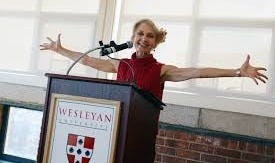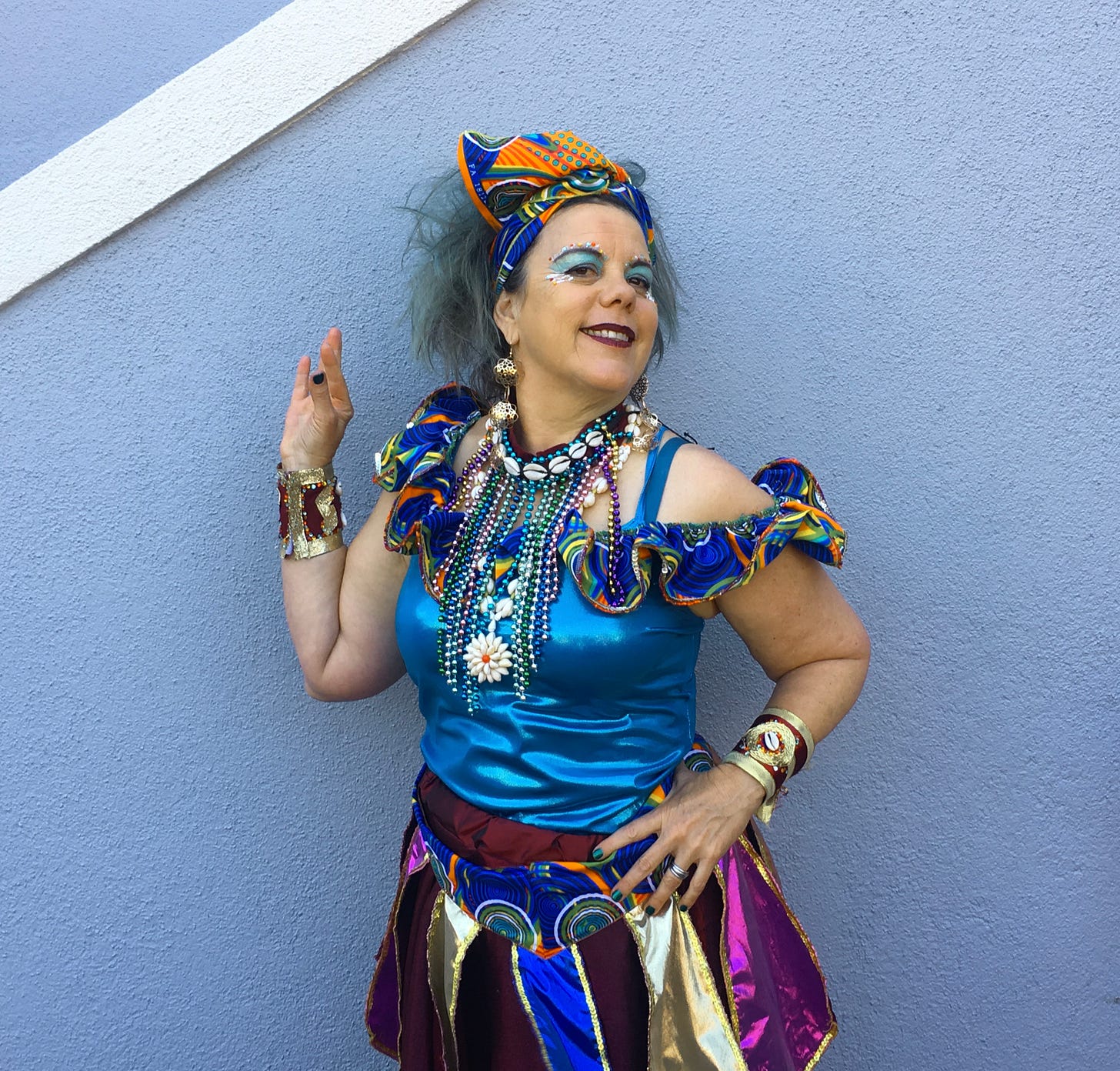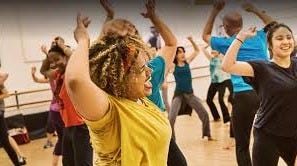
I heard the news today that Consuelo Faust, the founder of Rhythm and Motion, died this week, and it made me reflect on how important the dance community she created has been for me over the past forty years. I love to dance, and have long danced for exercise, spirit, and community. It isn’t too much to say that the dance company she created was fundamental in helping me change my body image.
When I was little, I wanted to be like the ballerina that popped up from my music box, delicate and skinny, like a fairy princess. She twirled on her toes in a cotton-candy tutu and tiny pink slippers. I liked to spin around my room along with her until the music slowed, the ballerina started to jerk, and I wound down too, stopping exactly when the music stopped in whatever position I was in, like Freeze Tag
Mom signed me up for ballet classes. We bought a black leotard and pale pink tights, and she showed me how to make a bun on the top of my head, about the size of my thumb. When the day for ballet class finally came, Mom drove me to the dance studio, which was sleek, with slippery wooden floors, giant mirrors, and a shiny black piano. You could see yourself on almost every surface. The lady at the piano played songs without sheet music, like magic. The teacher, Mrs. Frances, was tall and bony like a marionette, with a lipsticked smile that pulled at the cords in her neck. The other girls in class, dressed in identical leotards, fluttered like little birds until the teacher clapped and we all came to alight at the barre.
At the barre we did exercises, counting un, deux, trois out loud, like a secret language that only ballerinas can speak. We practiced all the positions, first through fifth, which is the one where we tried to turn our legs and feet out farther than anyone else. Most of the other girls were smaller and thinner than me, with sharper features and thicker buns on top of their heads. But I could turn my feet out sideways, touch my toes, and do a turn while spotting myself in the mirror, whipping around to see my reflection again. We did pliés and relevés, up and down, bending our knees then rising up on tippy-toe. I wanted to break away to sashay and spin around the room on my own but I held on tight to the barre. Un, deux, trois.
One day we were doing pliés in second position, with one hand balanced lightly on the barre, the other curved in space, up and down in time to the music. Mrs. Frances nodded at the girls at the barre, adjusting their arms, elbows up, reminding some to stand straighter. “Good,” she said to one or two. “Very nice.” Then she stopped at me. Her squinty gaze slid up and down my black leotard, which I always imagined wearing with a big fluffy tutu and a sparkling tiara. I stood up even straighter and beamed. I wanted her to tell me that I was good, good enough even to be in The Nutcracker some day. She frowned. Then she tapped me on my stomach.
“Ballerinas never have such big tummies,” she said, moving on.
I first moved to San Francisco in 1984, at a time when I was in the midst of a war with my body. I grew up keenly aware that I was “overweight,” though when I look back at photos I see I was simply a little round. My parents were slender and athletic, and believed that being chubby was a failure—of effort, will, discipline. I always felt clumsy and big as a child, convinced I was never any good at any sports, partly because no one ever believed I could play them or offered to teach me. I came in last in races, and was the last picked for teams.
It’s no surprise that I developed a serious eating disorder in college. All my time dieting and shame about my body had made an eating disorder inevitable. In San Francisco, I went to a therapist and understood intellectually how fucked up my relationship to my body was, but I didn’t feel it inside.
The only time I’d ever felt comfortable in my body was when I danced. I took ballroom dancing in high school, my only successful PE class. In college, I took an Intro to Dance class with a wonderful teacher named Cheryl Cutler, who managed to take a group of awkward college kids—the ones who’d never had ballet, or they wouldn’t be in the intro class—and make us feel graceful for an hour and a half twice a week.
She once videotaped us dancing. “Who is that graceful woman leaping around wearing a green leotard like mine?” I wondered when we viewed the tape. It was me.
Intro to Dance was my first step toward connecting with my own body in a positive way. From the time I took the class, I began dancing whenever I could. When I felt stressed, I put on music in my dorm room and danced. I danced at parties, and for the first time people noticed something about my body beyond its size—my movement.
The joyful beginning of dance classes faded the next semester, when I took a modern dance class that was more competitive, full of tiny dance majors vying to be in the front row. I didn’t take more dance classes, which I regret, particularly since the school had a great ethnomusicology department, which meant African dance classes with master drummers. Some part of me thought I should be taking more serious classes with my parents’ money, being ignorant at the time of how important it would become to me. But I went to the African dance concerts on campus whenever they performed, mimicking the movements of the dancers, letting the polyrhythms sweep through me, trying to feel them and respond to them in my body. Instead of losing myself in the music and the dancing, I was trying to be fully present to the sound and the spirit of the drums.
From dance I discovered a physical awareness, and a sense of grace. I also learned that you don’t always have to move in a dance, that it can be more powerful to pause. I would have to find that pause, those moments without the constant motion of stuffing or purging, and the incessant chatter of self-loathing, to be able to learn to feel, to be myself.

Dancing was the one time when I felt I could let my body loose and quiet my incessant concerns about my size. I had a lot of energy and enthusiasm for dance, but little technique or training.
That first year in San Francisco I found a gym near my apartment where I would swim sometimes, an activity I liked because it was weightless and solitary. I noticed that there was a dance class on the schedule, Rhythm and Motion. The idea of Jazzercise kind of bored me, because I preferred more expressive dance to an endless sequence of grapevines and kicks. The description of the class said it was taught by professional dancers, with choreography, but it was for any body at any level.
Sign me up.
I took that class and felt the joy of moving, along with the discipline of learning steps and choreography. I stood in the back, and was critical of my image in the mirror. But I was dancing.
Right away, I became something of a Rhythm and Motion addict. It was like a 12-step program for my body. When I was feeling fat (which was mostly in my head) and wanted to binge, to express my body shame, I went to a dance class instead. I began to feel more coordinated, more graceful. I knew the routines and I could begin to add my own flavor to them.
Consuelo Faust, the founder, died after a battle with Parkinson’s —a particularly cruel disease for a dancer. From New Orleans, she moved to the Bay Area to dance and created Rhythm and Motion in 1979 with fellow dancer Cathy Herbert. In a letter to the community, Dudley Flores, a longtime instructor, wrote, “She directed the company with two goals in mind: help dancers make a living by teaching dance, and that the joy of dance should be accessible to all. These simple ideas generated a community of teachers, students, and collaborators that has become the extraordinary, grass-roots institution that is Rhythm & Motion today.”
Rhythm and Motion was always a joyful and safe space for students, no matter their body size, race, gender orientation, or ability. It was the one place where I always felt there was a true cross-section of San Franciscans in class. It walked a fine line between accepting people as they are and challenging them, technically, to be better dancers. There was encouragement for everyone.
I took Rhythm and Motion classes until my knees squealed with tendonitis and I had to stop jumping. Then I tried a Latin Dance Grooves class at the studio, developed by Elizabeth Soberanes, who had been a R&M teacher, and began to dance salsa, learning Latin dance techniques. That turned into a full-blown salsa obsession.
I was so into Rhythm and Motion that I once told Consuelo I could never move to another city, because there would be no R&M. It was that fundamental to my life, my physical health, my spirit, and my sense of well-being.

Recently, while I was visiting the East Coast for a college reunion, I took a walk with a friend I’d only seen a handful of times in the decades since we were in school together. I met her in New York City for a stroll up Riverside Park, where fleshy pink peonies were blooming in their unabashed splendor.
I had always considered Liz, with her sea-blue eyes, long unruly curls, and quiet but definite voice, a kind of wise woman. She’d been calm and serene when we were 20, while I’d alternated between states of tumult, insecurity, and rash behavior.
When we greeted each other, Liz looked like she’d hardly changed, with just a few strands of grey in her dark hair. As we walked, we caught up on our lives. She’s married, a psychiatrist, with nearly grown children, involved in lots of counseling projects and a clinical practice. I am essentially what I was in college, a writer with no kids, though now with a few books, a lot of passport stamps, and after many years and false starts, a wonderful husband.
“I’m lucky,” I said. I felt lucky, too, to be out walking briskly, with no pain, no lurking disease, knock on wood. Lucky to be so physically healthy at this age.
“We appreciate our bodies now,” said Liz.
“Finally,” I said. “We have to, while there’s still time.”
In college, we definitely had not appreciated our smooth, strong, beautiful young bodies. We spent hours over tea talking about the topic that took up far too much real estate in our heads: food and weight. Sometimes I wonder how, with an eating disorder, I’d managed to keep it together enough to pass my classes, and I’m still mad at myself for all the opportunities I passed up at that intellectual banquet while I was off stuffing myself with junk food.
Liz and I were feminists who believed that a culture that criticizes women for their body size and eating is trying to keep them small, contained, and preoccupied, diverting their strength toward self-hatred instead of more important matters, like changing the world. Yet we couldn’t help fretting over fitting into our jeans, what we ate yesterday, and whether we’d ever be thin enough to be loved.
We felt that cognitive dissonance, Liz mainly in her head, and me, while emptying my guts.
It’s not surprising that our conversation on this walk turned to that old topic of body image.
“So how are you feeling about your body these days?” Liz asked gently. You can tell she’s a good shrink. She gets right to the heart of things without seeming at all intrusive.
“I feel great about my body,” I said. It just came out like that. Words I had never before uttered. It occurred to me to backtrack with self-deprecating comments about how I need to lose a few pounds and my upper arms are baggy, and blah blah blah, but fuck it. I didn’t have to apologize to Liz for feeling happy in my body instead of cataloguing my flaws. I feel just fine in my skin.
Liz stopped walking. She threw her arms around me, delighted, then pulled back to look at me. “That’s amazing,” she said. “How did you do that?”
I looked down at my shoes, considering this, tapping the ground for an answer. I found one. “I’m a good dancer,” I said. Here, too, I could’ve added a lot of denigrating qualifiers: For my age, for someone who doesn’t have a dancer’s body, who didn’t grow up in a culture that dances, who occasionally suffers so much social anxiety and self-consciousness that she misses the beat and flails around. But none of that matters. Dancing is just for the fun, the music, the playfulness of dancing with others, the pleasure of learning new moves, the discipline, the community. And at this age, after a lot of practice, I’m a confident dancer – yes, a good dancer.
Liz laughed. It sounded so simple.
“It’s more about how my body moves than how it looks from the outside,” I explained.
“That’s what I try to get my patients to understand,” she said.
It took me a long time to understand, and to feel. And Consuelo Faust’s Rhythm and Motion program, with its philosophy that any body can dance, was hugely important to me. For that, I’m so grateful to her, as I am to all the dance teachers I’ve had who looked beyond what my body looks like to how it moves.




Stumbled upon this and loved reading it. This resonates in so many ways. Thank you for sharing!
Yes you are a great dancer! And a wonderful writer! So deeply saddened for Consuelo’s long illness. Wishing her peace at last. My life if forever changed by Consuelo and the R& M family.